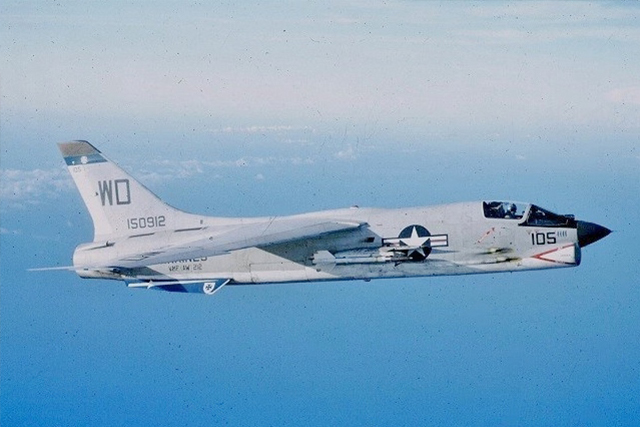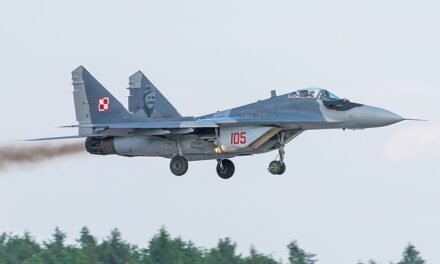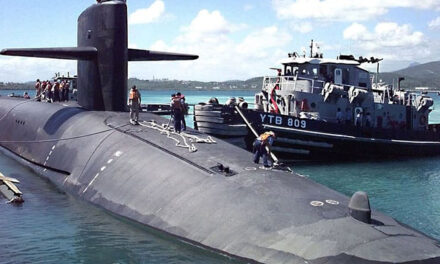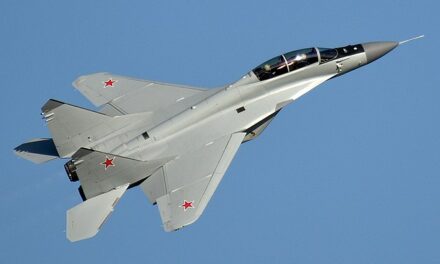Vought F-8 (F8U) Crusader
The Vought F8U or Vought F-8 Crusader is a single-engine, supersonic, carrier-based air superiority jet aircraft built by Vought to replace Vought F7U Cutlass for the United States Navy and United States Marine Corps, and the French Navy.
In September of 1952, the Navy Department announced Its need for a supersonic fighter of rugged construction, capable of having a top speed of Mach 1.2 at 30,000 ft (9,144.0 m) with a climb rate of 25,000 ft/min (127.0 m/s), and a landing speed of no more than 100 mph (160 km/h), folding wings, heavy firepower, resistance to open sea weather conditions, and simplicity of maintenance and handling. Eight different aircraft companies responded to the challenge with proposals and designs. The major competition came from the Grumman F-11F Tiger. In the end, Vought design eventually winning the contract.
Vought Aircraft had had phenomenal success with Its F4U Corsair design during World War Two but had fallen on hard times in trying to make the transition from the piston engine to the jet engine. In May 1953, the Vought design was declared a winner and in June, Vought received an order for three XF8U-1 prototypes. The first F-8 prototype was ready for flight in February 1955. The prototype flew on 25 March 1955 with John Konrad as a pilot. The flight lasted for just under an hour and firmly established the US Navy in the supersonic carrier aviation business by becoming the first shipboard aircraft to exceed MACH 1 in level flight, The Crusader did the unheard of, it flew supersonically on its maiden flight. On 4 April 1956, the F8U-1 performed its first catapult launch from a Forrestal-class aircraft carrier. The plane was also tested from a Bonhomme Richard-class aircraft carrier. Carrier trials were carried out with excellent results on both size carriers. The Crusader was ready for production and Fleet service.
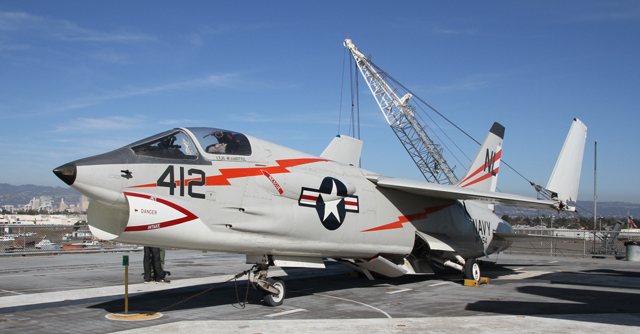
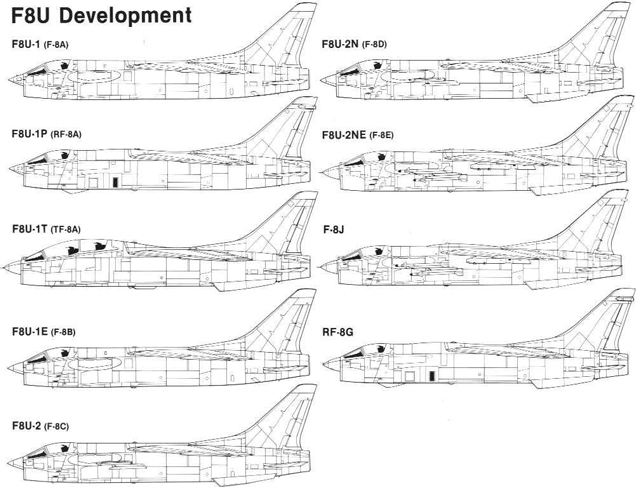
Specifications Vought F-8E Crusader
General characteristics
- Crew: 1
- Length: 55 ft 11.6 in (17.059 m)
- Wingspan: 35 ft 8 in (10.87 m)
- Height: 15 ft 9.1 in (4.803 m)
- Wing area: 375 sq ft (34.8 m2)
- Aspect ratio: 3.4
- Airfoil: root: NACA 65A006 mod; tip: NACA 65A005 mod
- Zero-lift drag coefficient: CD0.0133
- Drag area: 5.0 sq ft (0.46 m2)
- Empty weight: 18,800 lb (8,528 kg)
- Gross weight: 29,000 lb (13,154 kg)
- Max takeoff weight: 34,000 lb (15,422 kg)
- Fuel capacity: 1,348 US gal (1,122.4 imp gal; 5,102.7 L)
- Powerplant: 1 × Pratt & Whitney J57-P-20A afterburning turbojet engine, 11,400 lbf (51 kN) thrust dry, 18,000 lbf (80 kN) with afterburner
Performance
- Maximum speed: 1,066 kn (1,227 mph, 1,974 km/h) at 36,000 ft (10,973 m)
- Maximum speed: Mach 1.8
- Cruise speed: 268 kn (308 mph, 496 km/h)
- Stall speed: 135 kn (155 mph, 250 km/h)
- Combat range: 394 nmi (453 mi, 730 km)
- Ferry range: 1,507 nmi (1,734 mi, 2,791 km) with external fuel
- Service ceiling: 58,000 ft (18,000 m)
- Rate of climb: 19,000 ft/min (97 m/s)
- Lift-to-drag: 12.8
- Wing loading: 77.3 lb/sq ft (377 kg/m2)
- Thrust/weight: 0.62
Armament
- Guns: 4× 20 mm (0.79 in) Colt Mk 12 cannons in the lower fuselage, 125 rpg
- Hardpoints: 2× side fuselage-mounted Y-pylons (for mounting AIM-9 Sidewinders and Zuni rockets) and 2× underwing pylon stations with a capacity of 4,000 lb (2,000 kg), with provisions to carry combinations of:
- Rockets: 2× LAU-10 rocket pods (each with 4× 5 inches (127mm) Zuni rockets)
- Missiles:
- 4× AIM-9 Sidewinder or Matra Magic (French Navy only) air-to-air missiles
- 2× AGM-12 Bullpup air-to-surface missiles
- Bombs:
- 12× 250 lb (113 kg) Mark 81 bombs or
- 8× 500 lb (227 kg) Mark 82 bombs or
- 4× 1,000 lb (454 kg) Mark 83 bombs or
- 2× 2,000 lb (907 kg) Mark 84 bombs
Avionics
Magnavox AN/APQ-84 or AN/APQ-94 Fire-control radar
Vought F8 Crusader variants
Vought XF8U-1 (XF-8A)
XF8U-1 were the first two original unarmed prototypes. In March of 1955, the XF8U-1 prototype Crusader was loaded onboard an Air Force C-124 Globemaster and flown to Edwards Air Force Base where on 25 March the Crusader was flown for the first time. The most unique feature of the XF8U-1 was the variable incidence wing. This variable incidence, allowing the wing to be raised seven degrees, was accomplished hydraulically by a single-piston mounted in the forward starboard fuselage center section, allowing the entire wing to act as a giant flap by increasing the angle of attack by seven degrees. The rear spar was hinged and used as a pivot point. When the wing was in the down position during level flight it permitted supersonic speed to be easily attained. When raised into the up position it provided additional lift during take-off and allowed a landing speed of just over 100 knots for carrier operation. The total fuel capacity of the XF8U-1 was 1,165 imperial gallons which allowed about three hours of flying time. The flight controls were provided with three independent control systems for maximum protection from battle damage. For an escape from a terminally damaged aircraft, Vought provided the pilot with a piston cannon powered ejection seat.
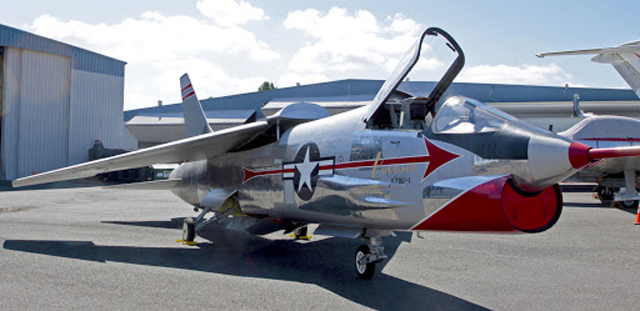
Vought F8U-1 (F-8A)
After only six months after the prototype flew for the first time and with very few changes from the prototype, the Chance Vought F8U-1 Crusader began to roll off the Dallas assembly line. The first production aircraft flying on 30 September of 1955 only some twenty-seven months after the contract was awarded to Vought. The first thirty F8U-1 Crusaders produced the Pratt and Whitney J57-P-12 engine later replaced with the more powerful Pratt and Whitney J57-P-4A engine providing a dry thrust of 10,900 pounds and 16,600 pounds in afterburner. Also, the original thirty F8U-1 aircraft were later retrofitted with the more powerful engine. The new engine allowed the Crusader to operate at altitudes near 50,000 feet and at speeds in excess of MACH 1.5. The Vought ejection seat, was soon replaced by the more efficient fully automatic Martin-Baker F5 seat.
The fuselage-mounted 20mm cannon armament was supplemented by single rocket launch racks mounted on each side of the fuselage just in front of and below the wing that was capable of handling heat-seeking Sidewinder missiles. The rocket drawer concept was retained, but it remained unused and was normally sealed shut.
In September of 1955, the Navy ordered the installation of probe type inflight refueling equipment on its fighter and attack aircraft. After the fiftieth production aircraft, the F8U-1 had refueling capability built into it with the early F8U-1s being retrofitted with refueling probes. The total number built is 318.
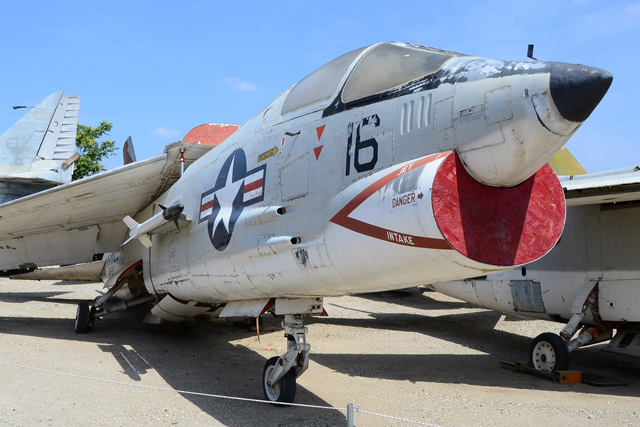
YF8U-1 (YF-8A)
One F8U-1 fighter is used for development testing.
YF8U-1E (YF-8B)
One F8U-1 converted to serve as an F8U-1E prototype. The F8U-1E prototype, a converted F8U-1 flew on 3 September 1958. Armament remained at four 20mm Colt cannons and two sidewinders, and although the rocket drawer was retained, It remained sealed.
F8U-1E (F-8B)
Essentially the same as the F8U-1, the F8U-1E was equipped with the AN/APS-67 radar scanner in the nose replacing the APG-30 fire control system and providing the F8U-1E with limited all-weather capability. After 315 F8U-1 Crusader day fighters had been produced, the F8U-1E replaced it on the assembly line.
The F8U-1E was capable of speeds in excess of 880 knots, had a service ceiling of 42,000 feet, and a combat radius of 345 nautical miles. 130 F8U-1ES were produced. In 1962 under DOD’s redesignation order the F8U-1E was redesignated to the F-8B.
DF-8F
In 1968 forty F-8A (F8U-1) are planned to be modified to F-8M standards but due to a lack of airframe availability, no F-8Ms were in fact produced. However, some F-8As were modified into the drone-controller configuration under the designation DF-8F. DF-8F stands for retired F-8A modified as controller aircraft for testing of missiles including at the USN facility at China Lake.
F-8L
In December of 1968 Vought began modification of the F-8B (F8U-1E) Crusader under a remanufacturing program designed to extend the service life of the Crusader. F-8B was remanufactured and designated F-8L. Upgraded with underwing hardpoints, and with AN/APQ-149 radar. This variant had instrument changes and cockpit modifications that brought about an increase in night flying capabilities. New catapult keels were installed where necessary and approach power compensators were installed to assist in carrier landings. Sixty-one F-8Bs were rebuilt as F-8Ls.
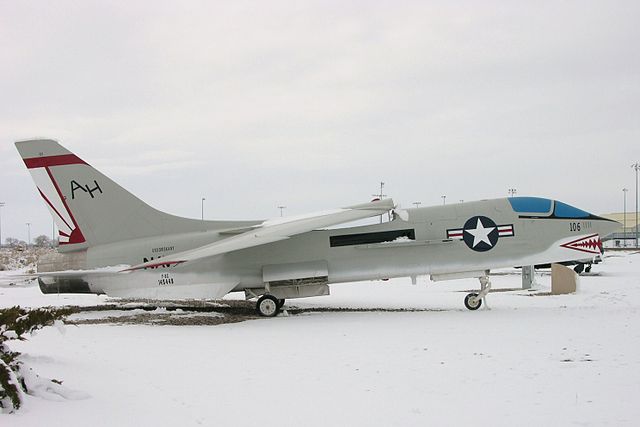
F8U-1P (RF-8A)
To fill a need for a fast high-flying photo-reconnaissance aircraft Vought developed the photo Crusader under the designation F8U-1P. The F8U-1P was identical to the standard F8U-1 from the wing-back, had a completely re-designed nose section. This was an unarmed photo-reconnaissance version of F8U-1E. All armament and fire control systems were removed and in their place Vought installed cameras. Three trimetrogen cameras, two vertical and one forward-facing, and provisions for the storage and release of photo-flash bombs for night photography. After successful prototype testing finished in 1960, 144 F8U-1Ps were built.
YF8U-2 (YF-8C)
Two F8U-1s used for flight testing the J57-P-16 turbojet engine. This more powerful installation resulted in a faster Crusader capable of 960 knots with a service ceiling of 41,000 feet and a combat radius of 320 nautical miles.
F8U-2 (F-8C) CRUSADER II
The first production F8U-2 flew on 20 August 1958 with Jim Omvlg at the controls. This variant was sometimes referred to as Crusader II. Introduced on the F8U-2 were ‘Y’ type missile racks that permitted the installation of four Sidewinder missiles (two on each rack). F8U-2’s had improved AN/APQ-83 radar and fire control capability. F-8C (F8U-2) Crusaders were flown in combat in Vietnam by both the Navy and Marine Corps. 187 F-8C (F8U-2) were built.
YF8U-2N (YF-8D)
One aircraft used in the development of the F8U-2N.
F8U-2N (F-8D)
To provide both the Navy and Marine Corps with a specialized night fighter, Vought built one hundred fifty-two F8U-2N Crusaders between 1960 and 1962. Production modification of the F8U-2, the F8U-2N featured improved and updated electronics including a more powerful AN/APQ-83 nose radar that provided night fighter capabilities. A number of F8U-2Ns were equipped with AN/AAS-15 infrared scanner. F8U-2N was an all-weather version. Unguided rocket pack replaced with an additional fuel tank, J57-P-20 engine with 18,000 lbf (80 kN) of afterburning thrust, landing system which automatically maintained present airspeed during the approach. The first flight was on 16 February 1960, 152 were built.
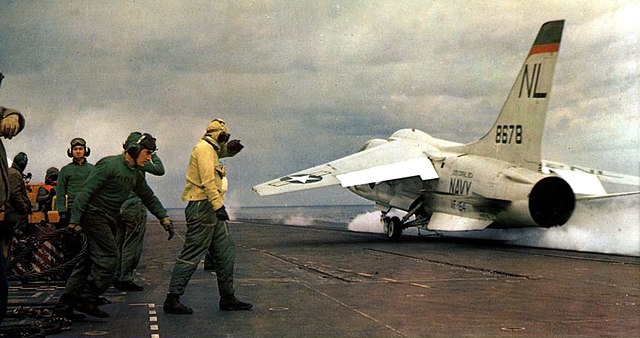
YF8U-2NE
One F8U-1 converted to serve as an F8U-2NE prototype.
F8U-2NE (F-8E)
Improving on the F8U-2N variant, Vought produced 286 F8U-2NE Crusaders for the Navy. The first flight was on 30 June 1961. This variant had a combat radius of 350 nautical miles, a service ceiling of 58.000 feet, and a gross weight of 34,000 pounds. Powered by J57-P-20A engine, the nose cone was enlarged and rounded to accept the more powerful AN/APQ-94 radar unit with a larger dish that allowed the F8U-2NE to seek out and attack a target at a greater range. The infra-red scanner mounted on the nose that first appeared on the F8U-2N was now standard. Dorsal hump between the wings containing electronics for the AGM-12 Bullpup missile, payload increased to 5,000 lb (2,270 kg), Martin-Baker ejection seat. Underwing pylons were added which could be used to carry an additional 600 gallons of fuel for extended flight or carry up to two 2,000 pounds of missiles, rockets, bombs, or ECM pods.
Early in 1962, the F8U-2NE completed its carrier trials aboard Forrestal aircraft carrier-class and shortly thereafter entered fleet service. The F8U-2NE was redesignated F-8E in late 1962.
XF8U-1T
One XF8U-2NE used for evaluation as a two-seat trainer.
F8U-1T (TF-8A) (V-408)
F8U-2NE was converted into a two-seat trainer by installing a second seat behind the regular seat, and a second full set of controls. In order to increase visibility, the second seat was raised 15 inches, and a completely redesigned and enlarged canopy was installed. Powered by a J-57-P-20 engine. Low-pressure tires and a drag chute installed for rough field landing The two-seater would be the only Crusader to be equipped with a drag chute. Under the designation F8U-1T the two-seater flew for the first time on 6 February 1962. It was redesignated TF-8A in 1962. Only one TF-8A was built, although several retired F-8As were converted to similar two-seat trainers.
F-8E(FN)
F8E(FN) was an air superiority fighter version for the French Navy, significantly increased wing lift due to greater slat and flap deflection and the addition of a boundary layer control system, enlarged stabilators, incorporated AN/APQ-104 radar, an upgraded version of AN/APQ-94.
The Crusader not only had an impressive performance, and was small enough to operate from French carriers, but its price tag was comparatively low. The only drawback was the 113-knot landing speed of the Crusader which was considered too hot for safe operation on French carriers. The 20mm cannon and Sidewinder capability was retained, but the French quickly added the capability of their own ordnance when rails to handle both the Sidewinder and French MATRA 530 were installed on the fuselage. A total of 42 F8E(FN) were built.
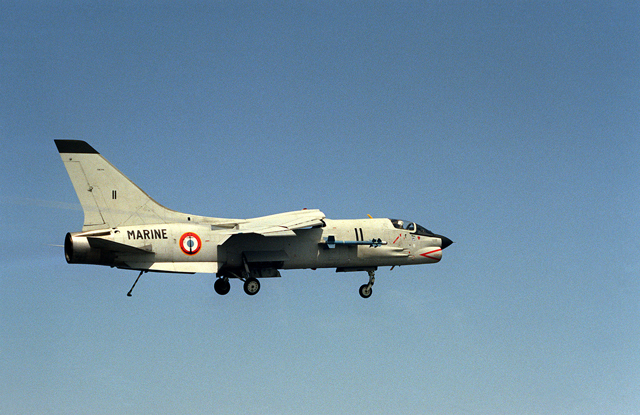
RF-8G
In 1965, remanufacturing was begun to update the RF-8A (F8U-1P) photo Crusader under the designation RF-8G. Seventy-three aircraft were re-built in two batches. The first batch fifty-three aircraft were re-built during 1965-67, and the second batch of twenty aircraft during 1968-70. New features of the RF-8G included multi-position openings for camera installation, ventral fins, a stronger wing spar, additional navigation, and electronic equipment including ECM antenna bulges on the vertical fin. The RF-8G was first flown by Vought Test Pilot, Joe Engle, on 31 August 1965.
F-8H
F-8H was upgraded F-8D with a strengthened airframe with the addition of armor-plating and installation of a new wing which was engineered to deliver 4,000 hours of service life. The landing gear was also strengthened, a longer nose gear was installed along with slightly smaller tires in all three positions. The F-8H Incorporated additional electronic changes to improve its offensive capabilities. Equipped with AN/APQ-84 radar. The F-8H had underwing pylons added for carrying ordnance. An easily identifiable external feature was a hump on the top of the fuselage over and forward of the wing, which housed a fire control system for the AGM-12 Bullpup missile.
In July of 1967, Vought started work on modernizing and remanufacturing the F-8D (F8U-2N) to the F-8H configuration and over the next twenty months, a total of eighty-nine F-8D Crusaders were updated to H standards.
F-8J
In January of 1968. Vought began the remanufacture of 136 F-8E (F8U-2NE) airframes into the highly modified F-8J version. The first F-8J flew on 31 January 1968. F-8J is upgraded F-8E, similar to F-8D but with wing modifications and BLC (Boundary Layer Control) like on F-8E(FN). Boundary Layer Control reduced the landing and catapult speed by fifteen knots as compared to the F-8E. The F-8J had a maximum speed of 950 knots with a service ceiling of 38.400 feet and a combat radius of 382 nautical miles. F-8J is equipped with AN/APQ-124 radar. The armament capability of the F-8J was unchanged from that of the F-8E.
F-8K
In December of 1968. Vought started work on another upgrade program modernizing and remanufacturing eighty seven F-8C models under the F-8K designation. F-8K was F-8C with Bullpup capability and J57-P-20A engines, with AN/APQ-125 radar.
F-8P
F-8P is the designation for Crusader in Philippine Air Force. Vought received a contract for twenty-five overhauled F-8Hs in 1977. Withdrawn from storage at Air Force Base in Arizona, twenty-five Crusaders were delivered to the Philippine Air Force under the designation F-8P. Also, ten other aircraft were delivered to the Philippines to supply spare parts for ten years.
F8U-1D (DF-8A)
Several retired F-8A modified to controller aircraft for testing of the SSM-N-8 Regulus cruise missile. DF-8A was also modified as drone (F-9 Cougar) control which was used extensively by VC-8, NS Roosevelt Rds, PR; Atlantic Fleet Missile Range.
F8U-1KU (QF-8A)
Retired F-8A modified into remote-controlled target drones.
Vought F8U-3 Crusader III
In parallel with the F8U-1s and F8U-2s, the Crusader design team was also working on a larger aircraft with ever-greater performance, internally designated as the V-401. Although the Vought XF8U-3 Crusader III was externally similar to the Crusader and sharing with it such design elements as the variable incidence wing, the new fighter was larger and shared few components.
In 1955, at the beginning of the F8U-1 program, Vought decided to begin work on what they felt would be Navy requirements for the next generation of fighters. Similar in appearance to the F8U Crusader and designated the F8U-3 Crusader III. the machine was in fact a totally new aircraft, although many of the same features found in the F8U were incorporated.
The Crusader III had automatic flight controls for holding a MACH number with the push of a button, was capable of operations in excess of 60,000 feet, and had a combat radius of close to 1,000 miles Gross weight of the Crusader III, Including 13.844 pounds of fuel, was 38.772 pounds.
Former operators of Vought F-8 CRUSADER

The United States

France

Philippines

